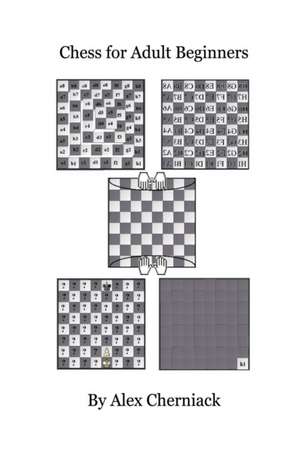Chess For Adult Beginners
Autor Alex Cherniacken Limba Engleză Paperback – 30 iun 2022
- The most important skill a chessplayer has is to see chess pieces move around the board from a position, thereby creating more positions, without touching a single piece (SEE IT IN YOUR HEAD). Without this basic ability, you are flying blind during a game.
- It's not enough to see a chess piece move from one square to another. The rub in seeing all these hypothetical virtual moves is that each and every single one of them must be evaluated in how they affect the current position. Aside from playing, the best way to learn how to evaluate is to read (BE LITERATE) from experts who have been publishing books for over 500 years.
- At the chessboard, good chessplayers have developed and honed four highly refined filters that block out the nonsense moves that waste time, and allow them to concentrate on the promising moves that lead to the best move possible. The first filter is to determine if your opponent is aiming any threats your way (SEE THROUGH YOUR OPPONENT'S EYES), as chess is no fun if all you are doing is walking into your opponent's punches.
- Once you have determined that there are no incoming missiles into your position, the second filter to apply is to visualize your own missiles (CREATE THREATS) that you can lob in the opposite direction towards your opponent. Chess begins to become a little fun when you can see how you can make your opponent suffer.
- The third filter to apply deals with the pesky neighbors that throw a wet blanket over many, if not most, threats: the pawns. You have eight pawns, and your opponent has eight pawns, for a total of sixteen, which occupy 25% of the board (CREATE THREATS, BUT BE AWARE OF PAWNS). Pawns put special local rules on threats, depending on how they are placed.
- The fourth and final filter is heuristics. Once you have determined that your opponent is not threatening anything, that you can create threats, and that you can create threats around or through the pawns, you have to choose the best move (IF YOU SEE A GOOD MOVE, SIT ON YOUR HANDS AND LOOK FOR A BETTER ONE). First you choose an initial list of candidate moves, and then choose among your choices.
- If there are threats to be found, you must develop your tactical ability (COUNT WHERE IT COUNTS) to make them count. Tactics are everywhere, even in the simplest positions, and make the chess world go around.
- If no threats in a position can be readily found, you must develop your strategical ability (PUT YOUR PIECES ON HIGHER GROUND), which is basically improving the integrity of your position at the expense of your opponent's. In chess, the more your pieces control the center, the better.
- If you have played well, you often reach the end of a game with a few pieces left on the board, and your opponent has none. Checkmate is what chess is all about (DON'T FLY A PLANE, LAND ONE), and you must know how to finish off your opponent with limited material, and know it cold.
- If you play long enough, you will discover what kinds of positions you like playing at the chessboard, and what kinds you don't (FIND AND REFINE YOUR STYLE). Seeing the best move is essential for playing good chess, but knowing thyself against an opponent is a must for becoming a better player.
Exercises are included, with answers in the back (more are available from the accompanying Chess Workbook for Adult Beginners).
Preț: 129.45 lei
Nou
Puncte Express: 194
Preț estimativ în valută:
24.77€ • 25.59$ • 20.62£
24.77€ • 25.59$ • 20.62£
Carte disponibilă
Livrare economică 04-18 martie
Preluare comenzi: 021 569.72.76
Specificații
ISBN-13: 9780692489666
ISBN-10: 0692489665
Pagini: 174
Dimensiuni: 152 x 229 x 9 mm
Greutate: 0.24 kg
Editura: Mindfast Publishing
ISBN-10: 0692489665
Pagini: 174
Dimensiuni: 152 x 229 x 9 mm
Greutate: 0.24 kg
Editura: Mindfast Publishing
